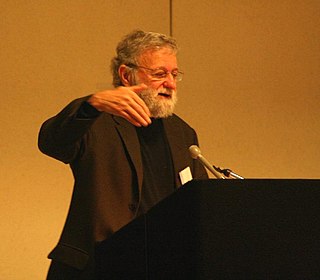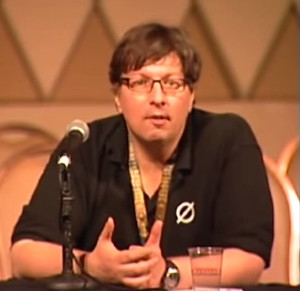Related Research Articles

Douglas Carl Engelbart was an engineer and inventor, and an early computer and Internet pioneer. He is best known for his work on founding the field of human–computer interaction, particularly while at his Augmentation Research Center Lab in SRI International, which resulted in creation of the computer mouse, and the development of hypertext, networked computers, and precursors to graphical user interfaces. These were demonstrated at The Mother of All Demos in 1968. Engelbart's law, the observation that the intrinsic rate of human performance is exponential, is named after him.

In computing, time-sharing is the sharing of a computing resource among many users at the same time by means of multiprogramming and multi-tasking.

The Conversational Monitor System is a simple interactive single-user operating system. CMS was originally developed as part of IBM's CP/CMS operating system, which went into production use in 1967. CMS is part of IBM's VM family, which runs on IBM mainframe computers. VM was first announced in 1972, and is still in use today as z/VM.

Donald Arthur Norman is an American researcher, professor, and author. Norman is the director of The Design Lab at University of California, San Diego. He is best known for his books on design, especially The Design of Everyday Things. He is widely regarded for his expertise in the fields of design, usability engineering, and cognitive science. He is a co-founder and consultant with the Nielsen Norman Group. He is also an IDEO fellow and a member of the Board of Trustees of IIT Institute of Design in Chicago. He also holds the title of Professor Emeritus of Cognitive Science at the University of California, San Diego. Norman is an active Distinguished Visiting Professor at the Korea Advanced Institute of Science and Technology (KAIST), where he spends two months a year teaching.
Extremely Reliable Operating System (EROS) is an operating system developed starting in 1991 at the University of Pennsylvania, and then Johns Hopkins University, and The EROS Group, LLC. Features include automatic data and process persistence, some preliminary real-time support, and capability-based security. EROS is purely a research operating system, and was never deployed in real world use. As of 2005, development stopped in favor of two successor systems, CapROS and Coyotos.
Tymnet was an international data communications network headquartered in Cupertino, California that used virtual call packet switched technology and X.25, SNA/SDLC, BSC and Async interfaces to connect host computers (servers) at thousands of large companies, educational institutions, and government agencies. Users typically connected via dial-up connections or dedicated asynchronous connections. The business consisted of a large public network that supported dial-up users and a private network business that allowed government agencies and large companies to build their own dedicated networks. The private networks were often connected via gateways to the public network to reach locations not on the private network. Tymnet was also connected to dozens of other public networks in the United States and internationally via X.25/X.75 gateways.
Capability-based security is a concept in the design of secure computing systems, one of the existing security models. A capability is a communicable, unforgeable token of authority. It refers to a value that references an object along with an associated set of access rights. A user program on a capability-based operating system must use a capability to access an object. Capability-based security refers to the principle of designing user programs such that they directly share capabilities with each other according to the principle of least privilege, and to the operating system infrastructure necessary to make such transactions efficient and secure. Capability-based security is to be contrasted with an approach that uses traditional UNIX permissions and Access Control Lists.
Tymshare, Inc. was a time-sharing service and third-party hardware maintenance company competing with companies such as CompuServe, Service Bureau Corporation and National CSS. Tymshare developed or acquired innovative technologies, including data networking (Tymnet), electronic data interchange (EDI), credit card and payment processing, telecommunications provisioning (COEES), office automation and database technology. It was headquartered in Cupertino, California from 1964 to 1984.
SRI International's Augmentation Research Center (ARC) was founded in the 1960s by electrical engineer Douglas Engelbart to develop and experiment with new tools and techniques for collaboration and information processing.
Computational science, also known as scientific computing or scientific computation (SC), is a rapidly growing field that uses advanced computing capabilities to understand and solve complex problems. It is an area of science which spans many disciplines, but at its core, it involves the development of models and simulations to understand natural systems.
KeyKOS is a persistent, pure capability-based operating system for the IBM S/370 mainframe computers. It allows emulating the environments of VM, MVS, and Portable Operating System Interface (POSIX). It is a predecessor of the Extremely Reliable Operating System (EROS), and its successor operating systems, CapROS, and Coyotos. KeyKOS is a nanokernel-based operating system.

z/VM is the current version in IBM's VM family of virtual machine operating systems. z/VM was first released in October 2000 and remains in active use and development as of 2020. It is directly based on technology and concepts dating back to the 1960s, with IBM's CP/CMS on the IBM System/360-67. z/VM runs on IBM's IBM Z family of computers. It can be used to support large numbers (thousands) of Linux virtual machines.

Matt Blaze is a researcher in the areas of secure systems, cryptography, and trust management. He is currently the McDevitt Chair of Computer Science and Law at Georgetown University, and is on the board of directors of the Tor Project.

East Stroudsburg University of Pennsylvania (ESU) is a public university in East Stroudsburg, Pennsylvania. It is one of the 14 state universities that compose the Pennsylvania State System of Higher Education (PASSHE).
The SDS 940 was Scientific Data Systems' (SDS) first machine designed to directly support time-sharing. The 940 was based on the SDS 930's 24-bit CPU, with additional circuitry to provide protected memory and virtual memory.

Capability-based Reliable Operating System (CapROS) is an operating system incorporating pure capability-based security. It features automatic persistence of data and processes, even across system reboots. Capability systems naturally support the principle of least authority, which improves security and fault tolerance. It is free and open-source software released under the GNU General Public License version 2 (GPLv2), and GNU Lesser General Public License version 2 (LGPLv2).
The Center for Analysis and Prediction of Storms (CAPS) was established at the University of Oklahoma in 1989 as one of the first eleven National Science Foundation Science and Technology Centers. Located at the National Weather Center in Norman, Oklahoma, its mission is the development of techniques for the computer-based prediction of high-impact local weather, such as individual spring and winter storms, with the NEXRAD (WSR-88D) Doppler weather radar serving as a key data source.
In capability-based computer security, a C-list is an array of capabilities, usually associated with a process and maintained by the kernel. The program running in the process does not manipulate capabilities directly, but refers to them via C-list indexes—integers indexing into the C-list.
In computer science, persistence refers to the characteristic of state of a system that outlives the process that created it. This is achieved in practice by storing the state as data in computer data storage. Programs have to transfer data to and from storage devices and have to provide mappings from the native programming-language data structures to the storage device data structures.
Ann Hardy is an American computer programmer and entrepreneur, best known for her pioneering work on computer time-sharing systems while working at Tymshare from 1966 onwards.
References
- ↑ Hardy, Norman. "Roots of KeyKOS". Cap-lore.com.
- ↑ Jordan, Dale E. (March 20, 1972). "GNOSIS Document". Cap-lore.com.
- ↑ Frantz, Bill; Hardy, Norman; Jonekait, Jay; Landau, Charlie (1979). "GNOSIS: A Prototype Operating System for the 1990s". University of Pennsylvania: Computer and Information Science. Archived from the original on December 5, 2009.
- ↑ "Gnosis (manual)". University of Pennsylvania: Computer and Information Science. Archived from the original on January 18, 2010.